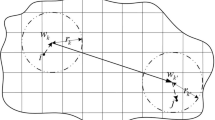Abstract
Automatic parking technology can overcome the difficulties of drivers in tight spaces during parking. In this paper, in order to improve the accuracy of parallel parking in tight spaces, a secondary parallel automatic parking method of endpoint regionalization based on genetic algorithm is proposed. Firstly, a secondary parallel parking method of endpoint regionalization is proposed and a collision constraint function is established by planning the secondary parallel automatic parking path and analyzing the possible collisions during parking. Secondly, the secondary parallel parking path is planed by estimating the minimum parking length and designing a reasonable terminal area for parking. The simulation made on MATLAB verifies the feasibility of the method. In order to improve the efficiency of secondary parallel automatic parking of endpoint regionalization and achieve the shortest automatic parking path, a parking path function with constraint conditions is established in this paper and optimizing is done by taking the parking path function as target function with genetic algorithm. The simulation results show that the secondary parallel automatic parking of endpoint regionalization based on genetic algorithm can enable cars to park in the designed terminal area correctly without collision and the parking path is shortened by 4.1% compared with that of the original one.








Similar content being viewed by others
References
Reeds, J.A., Shepp, L.A.: Optimal paths for a car that goes both forwards and back wards. Pac. J. Math. 145(2), 367–393 (1990)
Paromtchik, I.E., Laugier, C.: Autonomous parallel parking of nonholomic vehicles. In: Proceedings of the IEEE Intelligent Vehicles Symposium Minneapolis, MN, April, pp. 3117–3122 (1996)
Paromtchik, I.E., Laugier, C.: Motion generation and control for parking an autonomous vehicles. In: Proceedings of the 1996 IEEE International Conference on Robotics and Automation, Tokyo, September, pp. 13–18 (1996)
Müller, B., Deutscher, J., Grodde, S.: Trajectory generation and feed forward Control for parking a car. In: Proceedings of the International Conference on Control Applications, Munich, pp. 163–168 (2006)
Müller, B., Deutscher, J., Grodde, S.: Continuous curvature trajectory design and feed forward control for parking a car. Control Syst. Technol. 15(3), 541–553 (2007)
Li, H., Guo, K.H., Song, X.L.: Trajectory planning of automatic vertical parking based on spline theory. J. Hunan Univ. 39(7), 25–30 (2012)
Li, H.: Path Planning and Path Tracking Control of Automatic Parking System. Hunan University, Changsha (2014)
Demirli, K., Khoshnejad, M.: Autonomous parallel parking of a car-like mobile robot by a neuro-fuzzy sensor-based controller. Fuzzy Sets Syst. 160(19), 2876–2891 (2009)
Zhao, Y.N., Emmanuel, G., Collins, J.: Robust automatic parallel parking in tight spaces via fuzzy logic. Robot. Auton. Syst. 51, 111–127 (2005)
Rigatos, G.G., Tzafetas, S.G., Evanglidis, G.J.: Reactive parking control of nonholonomic vehicles via a fuzzy learning automation. In: Proceedings of the IEEE Control Theory Application, vol. 148, pp. 169–179 (2001)
Guo, K.H., Jiang, H., Zhang, J.W.: Design of automatic parallel parking steering controller based on fuzzy logic. Jilin Univ. J. 39(2), 236–240 (2009)
Guo, K.H., Jiang, H., Zhang, J.W.: Design of automatic parallel parking steering controller based on path planning. Jilin Univ. J. 41(2), 293–297 (2011)
Zheng, G., Liang, Z., Li, J.: Optimization of an intelligent controller for parallel autonomous parking. Talkomnika Indones. J. Electr. Eng. 11(2), 1069–1075 (2012)
Maravall, D., de Lope, J.: Multi-objective dynamic optimization with genetic algorithms for automatic parking. Soft Comput. 11(3), 249–257 (2007)
Hanafy, M., Gomaa, M.M., Taher, M.: Development of a technology for car’s auto-parking using swarm search-based fuzzy control system. Int. J. Model. Identif. Control 17(1), 85–97 (2012)
Lin, Z.Z., Li, Q., Liang, Y.J., et al.: Parallel parking algorithm based on autonomous path planning. Comput. Util. Res. 29(5), 1713–1715 (2012)
Tu, Y.Q., Cheng, H., Yang, H.Y.: Autonomous parking method based on human-simulated intelligent control. Control Eng. 21(2), 161–167 (2014)
Wang, L., Zhu, K.: Variable radius parking path study based on the shortest path. Auto. Sci. Tech. (6), 51–57 (2015)
Acknowledgements
This work was supported by the Fundamental Research Funds for the Central Universities and Cultivating Fund of Xi’an University of Science and Technology (No. 201745).
Author information
Authors and Affiliations
Corresponding author
Rights and permissions
About this article
Cite this article
Su, B., Yang, J., Li, L. et al. Secondary parallel automatic parking of endpoint regionalization based on genetic algorithm. Cluster Comput 22 (Suppl 3), 7515–7523 (2019). https://doi.org/10.1007/s10586-018-1809-8
Received:
Revised:
Accepted:
Published:
Issue Date:
DOI: https://doi.org/10.1007/s10586-018-1809-8




